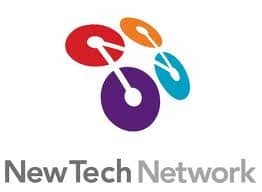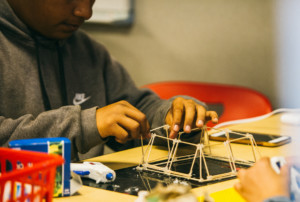A School for All Reasons

By: Tim Presiado
This post is part 1 of a three-part series on New Tech Network’s (NTN) annual data report and how NTN helps all students achieve success in college and career.
The data is in. And the results are excellent! Once again, New Tech Network’s annual data report demonstrates that schools can enable all students to achieve college and career readiness regardless of socio-economic status, geographic location or ethnic background.
As the report shows, a significantly higher than the national average rate of high school graduation, college enrollment and college persistence is evident in public New Tech schools in diverse communities across the nation.
The data report is not only about the numbers — it represents the many students whose lives are enhanced by the NTN teaching methods. NTN utilizes Project-Based Learning (PBL) with an emphasis on the principles of Deeper Learning. Data shows 42% of New Tech graduates enrolled in four-year institutions in 2012, compared to 38% of all high school graduates nationally; and 31% of New Tech graduates entered two-year colleges in 2012, compared to the national rate of 29%.It’s inspiring to review the data report and learn just how ubiquitous NTN’s teaching methods have become and how applicable they are to all types of students. This kind of education is beneficial for every student!
To gain first-hand knowledge of the student success rate at NTN schools, I recently talked with staff and administrators at schools representing a cross section of the NTN population — Bonsall New Tech High in Bonsall, CA — a suburban school about 45 miles north of the San Diego airport; New Tech Academy @ Ft. Wayne— an urban school in Ft. Wayne, Indiana; and Cross County High School, a rural school in Cherry Valley, Arkansas, about 120 miles from Little Rock.
These schools couldn’t be more different from each other, not only in terms of geographic location, but also the demographics of their students. In two of the three instances (Bonsall and New Tech Academy@ Ft. Wayne), local businesses had an influence in shaping the curricula that aided the career readiness of the students. Developing a viable local workforce was one of the key motivators in these communities selecting NTN as the school organization for its district.
Bonsall is the newest of the three schools to be discussed in this blog series. Set to open this fall with 100 9th grade students, Bonsall New Tech Academy Principal Tim Heck explained that when the high school opens, it will share a campus with Bonsall Middle School. However, the long-term plan is for Bonsall New Tech Academy to have its own campus.
Bonsall is a predominantly middle class suburb with the number of students participating in the National School Lunch Program (FRL) at only about 12%.
I asked Tim why Bonsall decided to work with NTN?
Tim explained that he grew up in the Bonsall area and understands the motivations of the community. “Bonsall has a long-standing tradition of educational excellence — with the highest API growth in the entire county. We have a strong community that really supports education,” said Tim. A recent ballot proposition asked the community to vote on Bonsall becoming a unified district with its own high school. Previously, it was only a K-8 district with local students attending high school in the neighboring towns.
Tim knew the job of Principal at Bonsall New Tech Academy was exactly what he wanted. “I had studied the NTN model,” he explained. “I believe that PBL is so much more than Common Core. The Common Core standards are trying to ‘catch-up’ with PBL. This alignment with the standards was perfect for our community — considering what’s happening with adoption of the Common Core standards — as well as what I want to do as an Administrator.”
Tim had used PBL in his own classroom at a very large traditional public high school, but found he wasn’t really supported by his peers. Until NTN, he had not been able to use PBL in a collaborative environment, build a team and make it work. “I had used PBL when I was a teacher,” he said. “But it was without the collaboration that is a hallmark of the New Tech experience. I am really looking forward to seeing PBL work in concert with a collaborative approach. I am excited to build this culture for our new school.”
In addition, Bonsall is undertaking a ‘backward conversion’ by turning its middle school into an NTN school.
As Tim pointed out, it’s not enough today to have students graduate with the ‘4 C’s’ — critical thinking, collaboration, creativity and communication. “We want our kids to be the kind of students that can present themselves as very qualified high school graduates who are prepared for the career they want to pursue.”
San Diego is home to a big aerospace industry, and, as Tim explained, is a growing region for biotech. He hopes to provide students internships in the biotech industry. “We’ve also entered into a consortium with other school districts to offer Microsoft and Cisco certifications in the areas of troubleshooting and coding so that students can either design or repair computer systems.”
Tim explained that Bonsall is looking at STEM courses (science, technology, engineering and math) for design, digital media and design thinking with a strong emphasis on a four-year SAT/ACT college prep program. “As those standardized tests are shifting towards Common Core, the students will also do well on the state exams,” said Tim.
Tim plans to establish a school leadership team comprised of parents, students and teachers. He hopes to partner with local businesses so the groundwork can be established for creating partnerships as well as developing other opportunities for business participation. “We’re very excited to launch Bonsall New Tech in the fall,” said Tim. “It’s a wonderful feeling for all of us stakeholders to have a sense of ownership in the building and operation of this new school.”
The next blog in this three-part series will focus on New Tech Academy @ Ft. Wayne in Ft. Wayne, Indiana, an urban school with more than 70% of students participating in the National School Lunch Program (FRL).
Tim Presiado currently serves as the Interim President of New Tech Network, Tim’s primary focus is to help cultivate and support new schools in the planning and implementation of the New Tech model. As President of New Tech Network, he directs strategy, new initiatives, product development, and school development services. Among the chief initiatives for New Tech are expanding its network of over 130 schools, digital learning for students and teachers, further development of the learning management system, NTN Echo and expansion into K-12.







0 Comments
Leave a Comment
Your email address will not be published. All fields are required.